Part 1: The decision was easy. We left Seattle on a typical rainy November day to travel to the Valley of the Sun, located in the Phoenix Arizona area. No one is sure who named this area, but it probably precedes the movie by the same name made in 1942, filmed in Arizona and staring Lucille Ball (trust some of you remember that redhead.) Phoenix is certainly dry with close to eight inches a year rainfall and holds a record of 160 consecutive with no rain over the fall/winter. However, we started this portion of the trip in Tucson which receives slightly more rainfall than Phoenix. (See Part 2 of this story here).
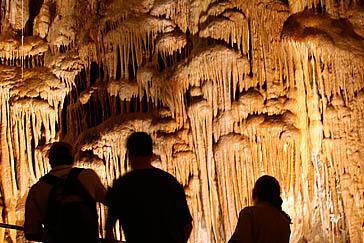
The interesting question is: why start our trip in this land of sunny skies with an hour and a half long hike in some very dark tunnels? Well, if in Southeast Arizona, one HAS to take in the dazzling display of Kartchner Caverns.
The caverns are located in Benson just an hour drive from Tucson. The first question is how are they formed? The recipe is simple: inland sea (300 million years ago), add small amounts of algae, shells, and coral. Steep in warm shallow water for many, many years.
Done? Not so fast! This limestone was uplifted when the Whetstone Mountains were formed. You then add rainwater and carbon dioxide to penetrate the limestone, which passes through to create tunnels. The final step is that the water table lowers and our magic recipe is complete - caverns made! Just add the frosting: more rain. Rain seeps through the limestone and dissolves the minerals that are deposited creating speleothems (cave formations) such as stalactites, stalagmites, straws and pillars. As a living cave, this process continues today, this part of the process continues today.
“I’m motivated by a longing to crawl through the next hole to see what was there.” That quote is from Randy Tufts who, along with friend Gary Tenen, discovered the cave in 1974.
Randy and Gary crawled through this cavern for 14 years, but kept it a secret because they knew that caves can be severely damaged by unregulated use. As part of their effort to safeguard the area, they then spent the next 29 years crawling through state bureaucracy. Finally in 2003 Kartchner Caverns State Park was open to the public. The park is named after the Kartchner family, who owned the land before it was sold to the state. The Caverns are home to many spectacular formations including the world’s longest straw stalactites (21 feet, 3 inches) and Kubla Kahn - the tallest and most massive column in Arizona (58 feet tall.) The park also offers RV, tent and cabin camping, educational events and a number of (above ground) hiking trails.
After spending some time watching the stalactites and stalagmites grow, it was time to check out the growth of some of the vines of the Sonoita AVA. The gravel based soil does not retain water and so is excellent for producing wine grapes. The igneous and sedimentary rock gives the wine a great complex structure.
We began our wine experience after a thirty minute drive to Kief-Joshua Vineyard in Elgin. The family-run vineyard has 20 acres here and 40 acres in the relatively new AVA in Willcox north of Elgin.
Winemaker Kief Joshua Manning greeted us and we sipped some wine while chatting about his very interesting path to winemaking. He started at Arizona State University (Tempe) where between classes, he spent his time learning to make wine and beer in his closet.
The wine making bug bit hard, so Kief decided to leave Arizona to attend the University of Melbourne in Victoria, Australia. He earned a graduate degree in enology and viticulture. Kief would travel back and forth to tend to his new vineyard in Elgin.
During our chat we enjoyed the Chenin Blanc and the soft taste of the Viognier, which had a light fruity nose of orange blossom and lemon. However our favorite was the Magdalena, which is a cuvee of mostly Barbera, balanced perfectly with Cabernet Franc. This had a light taste of pepper and fruits with a nice finish. These Arizona grapes certainly show very well.
The Magdalena is named after Kief’s late grandmother, who is also honored with a summer festival. This winery is certainly a family affair, with his dad and mother involved in the business. The family has deep roots in wine. Perhaps this is why they are so successful at producing really fine wines.
Before we left we asked why it has been a relatively slow process for the Arizona wine region to become so popular? Too hot? Too dry? Not at all! Although warm for the summer, 90 F with the dry high desert (close to 4,500 to 5,000 feet), temperatures drop down to 60 or slightly lower by the early morning. These temperatures help preserve acid levels and wine structure. In fact, many times Napa and Sonoma Valleys can also get such wide temperatures swings.
One might also assume it is too dry, but most areas get at least 16 inches a year and at some of higher terrain closer to 27 inches. In fact, this climate is similar to some of the popular world-wide warm and dry regions located at a similar distance from the equator. The Adelaide Plains Region in Australia (fourth largest in exports of wine to the world market) and the Coquimbo Region in Chile (fifth largest) both have comparable weather conditions.
However, the biggest limiting factor to wine production was Prohibition (1920 to 1933). Of course the federal Prohibition was a huge factor, but even after Prohibition ended, state law continued to prohibit wine making in Arizona. It wasn’t until 1982 that laws were passed to change that. Fast forward to today and there are over 110 wineries, vineyards and cellars in the state.
Prior to the Prohibition-caused interruption, Arizona’s actual wine production goes back centuries to the 1500’s when Jesuit priests of the Spanish missionaries planted wine grapes for their sacraments.
Due to time constraints we will need to wait for future trips to visit the many other wineries on the Sonoita AVA wine trail, such as Callaghan Vineyard. Callaghan can boast of their wine being served at the White House for both presidents George W. Bush and Bill Clinton. Seems like the wine had balance, politically speaking.
The next several days our goal was to discover more trails in Cochise County (Southeast Arizona-near the Mexican border). After discussing Arizona wine history it was time for nourishment and we drove south 40 minutes to the Outside Inn in Sierra Vista.

We were greeted by executive chef and owner Patrick Malarchik who was extremely happy and full of excitement. Patrick had a good reason to be excited, because he and his wife, Ayana, recently took over this restaurant that has been serving food since 1993. He was even more excited because they were expecting the birth of their first child. Patrick did mention that he might need to leave in a hurry.
Patrick and his wife have over 32 years combined restaurant experience, much of it in the Tucson area. Patrick is from Serra Vista, so he was especially happy to leave the corporate restaurant world to return home.
We first had Dumpling Soup, and the combination of mushroom and bacon was a very tasty mix. The bacon is cured on site, which is Patrick’s style: fresh food, locally sourced. Sharing of appetizers was the rule of the evening so we started with the Crab Cakes, made with sweet blue crabs, wild mushrooms, and garlic and fried in a light batter. The Shrimp Cocktail was our next fresh treat of prawns from Guaymas, Mexico which is well known for shrimp. One more appetizer then arrived, Short Rib Wellington which was moist and tender, braised in Béarnaise sauce with onions and mushrooms.
Were we done? No, since we still had to order the main course! I ordered the Filet Mignon, char grilled to perfection with Bordelaise and just enough red wine to enhance the taste. It was served with their home cured bacon and grilled asparagus.

My wife enjoyed the special for the night, which was shrimp and scallops served with asparagus. Our host enjoyed the Shrimp Carbonara served in cream sauce and bacon on bed of linguine.
Patrick checked in and was surprised at how well we did with all of that wonderful food (one needs to remember that our day started in Seattle at 5 am, and prior to dinner at 7 pm we had eaten very little during a very busy day!) He tried to tempt us with some amazing looking desserts, but we really needed to wave the white flag and surrender. We said goodbye to Patrick and thanked him for one of the best dinners that we have ever eaten. We also wished him and his wife congratulations in advance of their new born! We found out later that their son was born several days after our memorable dining event.
On the way home we chatted with Judy from the City of Sierra Vista about a game plan for the next day with the intention of burning some calories off. Judy mentioned the vast system of Bicycle & Shared Use Paths with 30 miles of trails Of course we didn’t have a bike with us, but Judy said the local library will lend you a free bike for up to three days! For those more serious bikers, there is also a great network of mountain bike trails.
We went to bed undecided whether to hike or bike, so we determined to make a final decision over breakfast at a local favorite in Sierra Vista. The Landmark Café is a well-loved eatery that has been a gathering place for locals since 1978. Our first order of business was easy, with being so close to the Mexican border (40 minute drive to border at Naco, AZ.),the Southwest Omelet was a great choice. The Café serves breakfast all day, along with lunch, dinner, and catering.
We continued our discussion about the day’s activities and saw that one of the bike routes, Elgin Loop, goes through Fort Huachuca. (4.3 miles west of here) Judy told us the Fort and The Landmark Café have an intertwined relationship.
The Fort’s history, which goes back to 1877 defending settlers against the Chiricahua Apaches, also housed solders during World War II and the Korean War. The Fort was annexed to the City of Sierra Vista in 1971. Now it is a national landmark and still serves as the command headquarters for the U.S. Army Network Enterprise Technology Command (NETCOM).
During World War II and after, Huachuca Fort used The Landmark building for recreational and USO activities for the personnel. The current owner, locally born Pam Anderson, began working there as a waitress in 1989. Three years later she became the proud owner.
Just before we left the Café, Judy of Sierra Vista shared an interesting fact about the city naming process via a public vote. Judy said when the city was incorporated in 1956, there was an underhanded matter in which the name was selected. The lady in charge of counting the ballots never really counted the ballots but announced that the winner is Sierra Vista. Nice name!
The biking looked tempting but we decided on hiking instead. We were very lucky to have a guided hike into Ramsey Canyon Preserve.
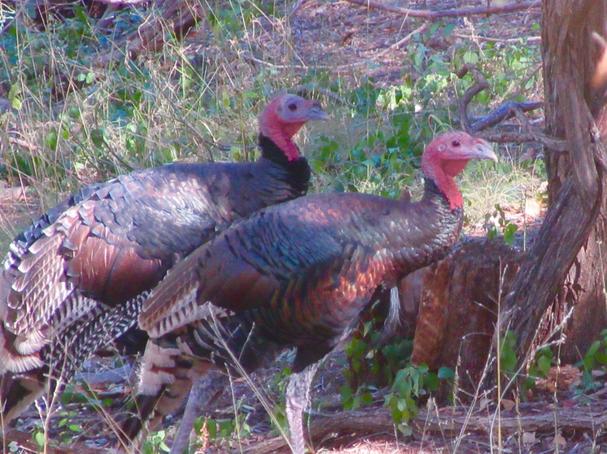
We enjoyed the short 29 minute drive to the Ramsey Canyon Reserve. and once in the Preserve we were greeted by two turkeys, representing just one of over 150 species of birds found in the Preserve. The Preserve is part of the area known as the Madrean Sky Islands, made up of 27 Sky Islands located in Southeastern Arizona, Southwestern New Mexico and Northwestern Mexico.
Sky Islands are isolated mountain peaks surrounded by radically different lowlands. This is certainly the case here as we have the Huachuca Mountains with Miller Peak checking in 9466 feet, surrounded by the Upper San Pedro River Basin. This diversity in terrain results in a wide diversity in birds.
Our guide, Chris Chappell, who has a MS in Forest Ecology, shared his wealth of information while explaining and identifying birds (some by sight and some by sound.) We asked how far the trail goes and he said if we wanted a supreme challenge we can take the Sky Island Summit Challenge. Three peaks with an elevation gain of 5146 feet and 18 miles long! Chris must be up to the challenge since he could hike all of those miles, make bird calls and talk to us all at the same time. However, we were not up for that!
We enjoyed the cool fall day and mellow hike. Chris said that April and May tend to be the best for bird watching, since that is breeding and migration time. Sierra Vista is known as the Hummingbird Capital of the World, so we weren’t surprised to see our first Anna’s Hummingbird, which is just one of 14 hummingbird species found here. Then a Rufous Hummingbird came to one of the many the feeders. That one looked familiar and sure enough we have seen them fighting off other birds (and each other) at our feeder back home in the Seattle area.
We covered lots of ground during our three hour hike in the canyon and we were also excited for our next adventure that would again take us underground. After a 30 minute drive to the southeast we arrived in Bisbee for the Queen Mine Tour.
Bisbee has done a wonderful job of embracing its roots and maintaining the charm of a small historic town while becoming a modern day cultural center with many shops, art galleries, restaurants and live theater. Since the town was built prior to the existence of automobiles, downtown Bisbee is very compact and walkable. And – it is very hilly, exemplified by the old High School building which is four stories tall and has a ground level entrance on each floor! Bisbee has been honored with the designations of Best Historic Town, Most Alive Place to Retire, and one of America’s Quirkiest Towns by major national magazines.
There is no doubt Bisbee’s history is tied to the largest copper producing area from the late 1800’s until the mine closed in 1975. Production was 8,032,353,000 pounds of cooper and even 2,871,786 ounces of gold and some silver were mined.
Donning our hard hats and climbing aboard the mine trains, our guide took us deep into the earth, and not so far back in time. All of the guides are retired miners having worked for the Phelps Dodge Corporation at the Queen Mine, or another one in the region. The tour was such an authentic experience, from the original equipment still in the mine, including the mine train we rode in on, to the personal look into what life and work was like for our miner -turned-tour-guide. Oh boy, did those men work hard! (Queen Mine closed before women passed that particular gender barrier.) The work was dangerous, dirty, and difficult. And probably not very well paid, but our guide obviously took pride in his long career as a miner. His “war stories” and wry observations kept us entertained for the one hour tour. Often when we travel, there are some excursions that seem like they could be skipped as just another touristy thing. This was not that!
With all of the talk of hard mining work we were looking forward for dinner at Bisbee’s Table.

The Page family commitment to Bisbee started in 1995 with Bisbee Coffee Company, which quickly became a popular local hang-out. Regular customers have their own coffee mugs on the premises, and if you didn’t show up for your daily dose of coffee the owners would seek you out.
Bisbee’s Table is a Page family affair with seven family members involved in several of their local businesses. My dinner selection was meatloaf, prepared with a red wine demi-glace and topped with crispy fried onions. Definitely superior to the ketchup-topped meatloaf from my childhood! So tender and so tasty. I asked owner Suzanne Page if they bottle and sell the sauce and she said not yet. Bisbee Table is known for their hamburgers, made with house-ground chuck and brisket cuts. My wife was partial to their famous Bleu and Black Burger severed with sweet potato fries. According to her their burger rep is well deserved. Very juicy and tender.
We wondered if the Bread Pudding we ordered was going to be too much. If you want bread pudding, you have to order it before you actually know whether you’ll still be hungry. The thirty minute bake time means that the one you get is fresh out of the oven. And it was truly heavenly! Crispy bread with cinnamon, hot butter sauce and ice cream. It was so good we were almost able to finish it all but left a little bit. Next time we come, we might just start with this.
We took the short walk through Old Bisbee to our residence for the evening, Copper City Inn. On this relaxing fall evening we sat outside on the baloney and enjoyed the views overlooking the street below and the surrounding hills. Although there was a big sports game on TV I was so relaxed and enjoying the peace and quiet that I skipped it. The owners, Fred and Anita, are like many of the folks that are small business owners who have lived here a long time and are all very involved in the community. Others are from other regions and come here on vacation, fall in love with the area and stay. We were starting to feel that way.

The next morning was sad as it was time to leave, but the smells from Ana’s Seasonal Kitchen helped us to decide to spend another hour or so here. Ana is chef and owner and fuses her knowledge of Mediterranean cuisine (she’s from Spain) with the fresh and seasonal ingredients from the Southwest. As a lover of a little spice in the mornings, The Mexican Scrambled Eggs was an easy choice. The local chorizo and mildly spicy roasted Polanco Chile and house potatoes were excellent. My wife equally enjoyed the “Iron Man Scrambled Eggs" served with red and green onion, tomato, spinach and parsley. The café is small and homey. Almost like stopping by a friend’s house – if your friend is an excellent cook!

Image courtesy of Tom Nelson
Just having that Iron Man my wife felt energized and suggested that we hike Chihuahua Hill. The trail is easily accessed on foot from the restaurant and the hike is 2.3 miles with just over 700 foot gain. Ideal to tackle with a happily full stomach.

Our next stop was a short 25 minute drive north to Tombstone. We wanted to make sure that the corral was okay, and it was. If you dive into history you will see that fateful October day in 1881 when horse-thief-turned-law-man Wyatt Earp, his brothers Virgil and Morgan and temporary policeman Doc Holliday had had enough of trouble-making cattle rustlers of the likes of Billy Clanton, Tom and Frank McLaury. Known as the most famous shootout in the American Wild West, the Gunfight at the OK Corral lasted 30 seconds, left 3 outlaws dead and 3 of the lawmen injured. Wyatt went on to live a long and interesting life,. He died in 1929 as the last surviving Earp brother (there were 4 of them) and the last survivor of all who participated in the famous Gunfight. In 1957 the Tombstone Restoration Commission went to Los Angeles (where he had died) intended to have his remains moved back to Boot Hill Cemetery – but no one could find them. Turns out his wife Josephine, who was of Jewish heritage, had him secretly buried at the Jewish Hills of Eternity Cemetery in Colma, CA. Plans for relocation were abandoned, and he remains there to this day. However, the bodies of the outlaws are buried in Tombstone at the Boot Hill Cemetery. So – while we didn’t find Wyatt’s (or any of the brothers) grave on Boot Hill, it is still a very interesting stop. Many of the gravestones tell a fascinating history of the town and the area.

We left Tombstone without finding out why the Earps and Holliday had initially been charged with murder but the charges were later dropped by the Tombstone justice of the peace. We decided it was time for peace and tranquility and headed to one of the best kept secret gems in the United States: Chiricahua National Monument.
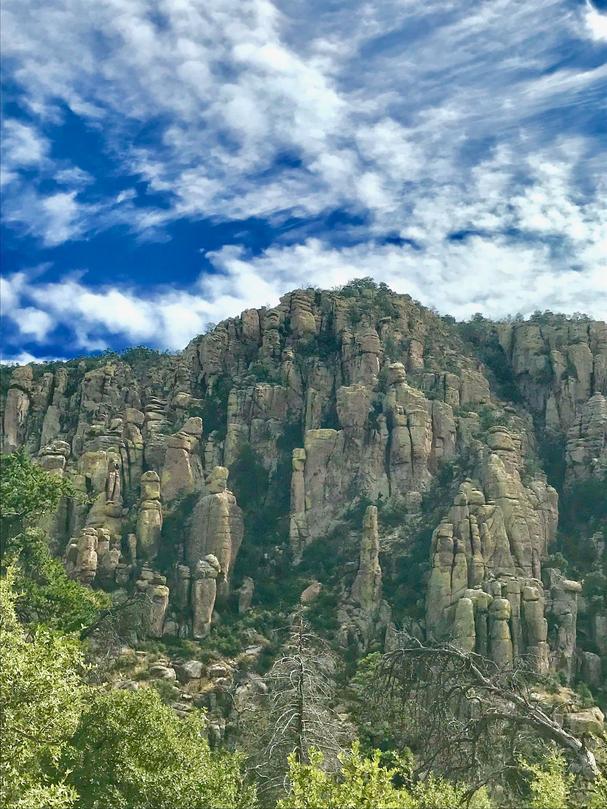
The Chiricahua called this area “The Land of the Standing Up Rocks.” Geologically speaking these rocks, called rhyolite tuffs, were formed by a volcanic eruption.
To get a better view we hiked the Natural Bridge Trail which is just under 5 miles round trip with under 700 elevation gain. The Park is open year around and is well worth a visit. The Natural Bridge Trail starts at 5520 feet so it’s usually snow-free even in the winter. That may not be the case for other trails in the park, such as Massai Peak which starts at closer to 7,000 feet.
Our trail starts off crossing the Bonita Creek (dry but during heavy rain can raise quickly) and you pass a stand of oak and cypress trees, intermingled with giant boulders that are no longer “standing up.” We started to get above the tree line where the views opened onto an other-worldly landscape. The high pillars of rocks went on as far as the eye could see. Some of the boulders seemed quite precariously balanced.
After our hike, we needed to get to our wine tasting in Willcox. In less than an hour’s drive we went from the mountains to the agriculture center of Arizona and to Coronado Vineyards.
Willcox had just received the official AVA (American Viticultural Area) designation in 2016. Farmers and ranchers have known of the riches of this area for many, many years. In the late 1800’s, 20 million cattle had been driven from Texas to Willcox, then railed to points east. The area was thought of as the “Cattle Capital” of the nation. Th cattle industry is still big as ranchers produce enough beef to feed over 4.6 million Americans.
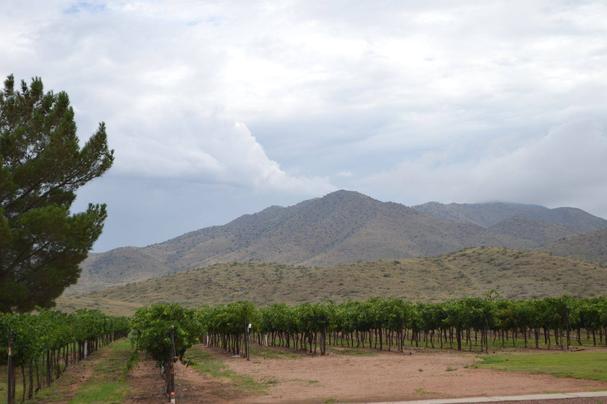
Willcox is in the Sulphur Springs Valley and is surrounded by mountains. The eroded soil provides a perfect balance of sand, silt and clay and great drainage to recharge the aquifer. What makes this area great for wine grapes is that the vine roots are forced to dig deep into the alluvial soils during the warm summer days, which stresses the wines to the just the right extent.
Mark Cook, one of the winery owners, has family farming roots back to the 1880’s including ranching and farming. Currently he grows wine grapes and pistachios. Our wine tasting began with the Voodoux (Chenin Blanc with French Coloumbard), a very crisp, slightly sweet wine with fruity flavor notes. Moving into the reds, we then tasted the medium-bodied blend, Two Heads Red, which is slightly dry and has a light oaky finish. It is a blend of Cabernet Sauvignon and Sangiovese and was definitely our favorite. A fuller bodied very deep red Malbec came next with a very interesting blend of earthy and fruity flavor. Also very good. Actually choosing a favorite is often one of our most difficult tasks. The winery has won many awards over the years from 2009 through 2013 under the direction of winemaker Jacque Cook (Mark’s wife.)
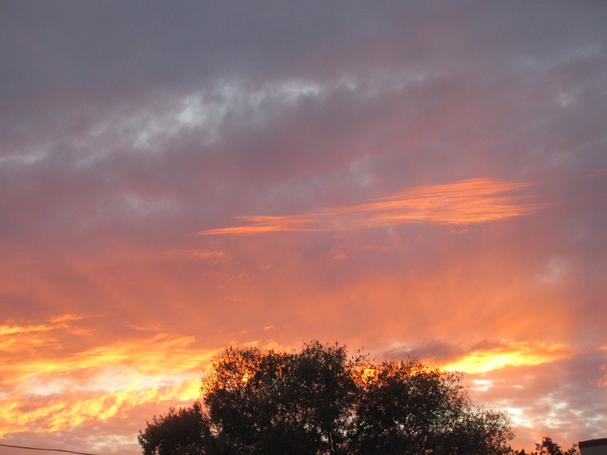
We took in the gorgeous sunset as we drove through the peaceful countryside. The scenery included lots of cattle. Local folks point out that there are more cows than people in Willcox, pop. 3,511 according to the US Census. We also drove past some more vineyards and wineries. As the sun set, we realized that we had worked up quite an appetite so headed for the Big Tex Bar-B-Que.
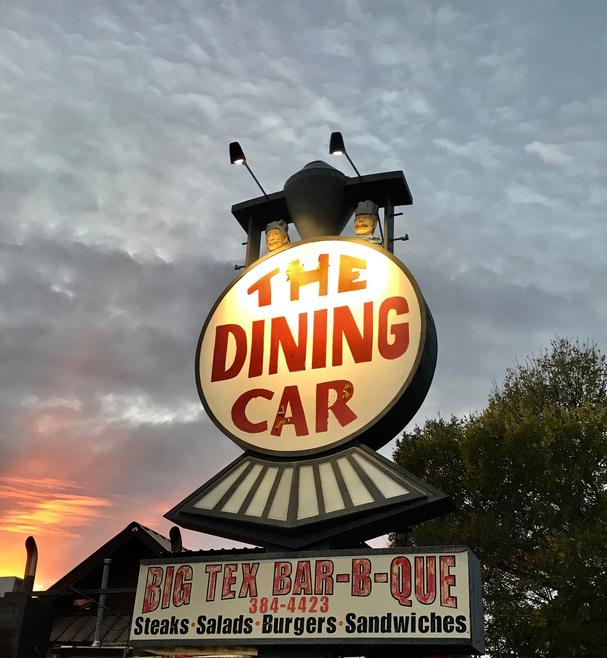
To capture historic Willcox the restaurant is in an old railroad dining car. The compelling aroma of BBQ sauce hit us in the parking lot. It was difficult to choose from their extensive menu, everything looked so good. All meats are smoked in-house and served with their signature BBQ sauce. My wife went with the Barbeque Brisket Sandwich, which she loved so much that she declined my offer to share. I ordered the Regular Plate of pulled pork and came with a choice of potato salad, coleslaw or beans. The BBQ sauce had a slight kick – nice spice balance that did not overcome the other flavors of the sauce and meat.
Sadly, we were able to spend less than ten hours in Willcox, so a return visit to Cochise County is in our future plans. We unquestionably need to check out more wineries and spend at least an entire day hiking in the Chiricahua National Monument. A great time to visit would be in January for the annual (25th in 2018) Wings Over Willcox. The festival, which takes place during the winter migration of a huge number of bird species, offers tours and seminars on photography, geology, history, botany and agriculture.
Our next installment will include the highlights and delights of our stop in the Greater Phoenix Area.
Written by Michael Fagin, edited by Elizabeth Fagin. Disclosure: Please note that food and lodging was complimentary.
Image Sources:











